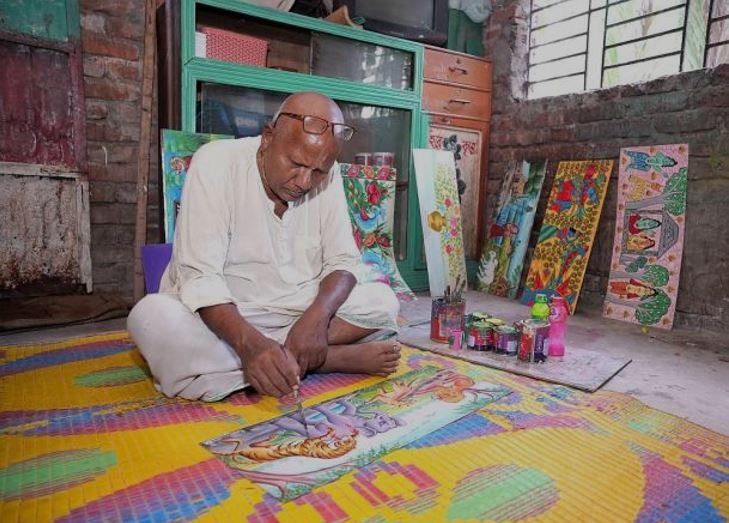Key highlights:
- The Intergovernmental Committee for the Safeguarding of the Intangible Cultural Heritage added ‘Rickshaws and Rickshaw Painting in Dhaka’ to the Representative List of the Intangible Cultural Heritage of Humanity on 6 December 2023
- Artists specializing in rickshaw painting often work on a commission basis, sharing their expertise and skills with their offspring and close family members
- Many city stores feature home decor adorned with rickshaw art to transform our living space effortlessly
- The Shital Pati weaving of Sylhet joined the prestigious list in 2017
Referred to as Dhakar Rickshaw or Rickshawchitra, Rickshaw Art stands out as an extraordinary form of decorative art adorning the vehicle bodies throughout Bangladesh. The Rickshaw, a three-wheeled human-powered transport, holds iconic status in both Dhaka and the broader context of Bangladesh. The manual crafting of Rickshaws has gained widespread acclaim for its traditional approach to design. Virtually every component of a Rickshaw in Bangladesh is meticulously adorned and painted.
The artistic practice of rickshaw painting, indigenous to Bangladesh, is characterized by its striking use of colors. What started as a tactic to entice customers with brightly painted rickshaws has now evolved into a cultural symbol that mirrors our lives. With passion-infused practice and a legacy of transmission, this element has solidified its presence within the city’s cultural fabric, emerging as a noteworthy manifestation of urban folk art.
During its 18th session in Kasane, Botswana, from 5 to 9 December 2023, the Intergovernmental Committee for the Safeguarding of the Intangible Cultural Heritage added ‘Rickshaws and Rickshaw Painting in Dhaka’ to the Representative List of the Intangible Cultural Heritage of Humanity on 6 December 2023.
The Shital Pati weaving of Sylhet joined the prestigious list in 2017, following the inclusion of the Mangal Shobhajatra on Pahela Baishakh, the age-old craft of Jamdani weaving, and the soulful tunes of Baul songs.
Tracing the Evolution of Rickshaws in History
In the late 17th century, France introduced the first rickshaws as a response to the growing need for public transportation following the discontinuation of Paris’ initial omnibus service in 1679. The inception of rickshaws in Japan took place around 1869, emerging independently after the ban on wheeled vehicles from the Tokugawa period (1603–1868) was lifted. This development coincided with a period of rapid technological progress in Japan, marking a significant milestone in the history of transportation.
By 1930s, pedal-powered rickshaws were a common mode of transportation in Bangladesh, Kolkata, India, and Jakarta, Indonesia. Their popularity spread across various South and East Asian countries by 1950. As the 20th century drew to a close, Dhaka alone boasted a fleet of 300,000 of these vehicles.
Rickshaw Painting as a Living Art Form!
Following the Liberation War, rickshaw artists passionately illustrated the war’s atrocities and the courageous countenances of heroes, displaying a strong sense of patriotism. In the mid ’70s, figures ranging from film stars to everyday individuals adorned rickshaws, prompting a shift in focus to mythical creatures by the artists—a captivating and imaginative evolution!

In the early ‘80s, celebrities adorned rickshaws, riding with sunglasses, iconic hairstyles, rosy cheeks, and captivatingly large eyes—capturing the fascination of onlookers. While film influences dominated rickshaw art, the vibrant streets of major cities also showcased cheerful animals, Taj Mahals, floral patterns, religious motifs, rural landscapes, and even airplanes.
Due to their leisurely pace, the paintings and decorations on these unhurried vehicles easily catch the eyes of passersby, transforming them into a mobile art exhibit. According to UNESCO, adorned rickshaws serve as a symbol of urban life in Dhaka, inspiring exhibitions, festive events, and frequent appearances in films and other artistic endeavors. Top of Form
The age-old tradition of crafting rickshaws is passed down through the generations by skilled artisans in rickshaw workshops, relying on both spoken instructions and hands-on training. Artists specializing in rickshaw painting often work on a commission basis, sharing their expertise and skills with their offspring and close family members.
While the craft of rickshaw making is predominantly male-dominated, the realm of painting these vehicles includes both men and women artists.
The Intricate Beauty of Rickshaw Art Finds a Place in Fashion and Homes

From the start of the new millennium, clothing featuring the artistic flair of rickshaw painting has emerged as a major fashion trend, allowing individuals to customize their look with either a traditional or modern twist.
The design embraces a vibrant palette, featuring lively patterns depicting birds, flowers, and elements from nature. Rich hues such as yellow, red, blue, and green blend harmoniously, evoking the beloved traditional aesthetic of rickshaw art that holds a special place in the hearts of Bangladeshis.
These captivating motifs adorn a variety of garments, including saris, shalwar kameez sets, and kurtis. Crafted from an array of fabrics, these outfits are versatile enough for everyday wear while also making a stylish statement at more formal occasions.
Apart from fashion, many city stores feature home decor adorned with rickshaw art to transform our living space effortlessly by incorporating cushion covers adorned with floral motifs or city scenes, instantly creating a cozy sitting area perfect for afternoon tea. Top of Form
Quilts crafted from a medley of fabrics are currently in vogue, and the distinctive paint expressions found on rickshaws can elevate their elegance even further among the glitterati. Wall hangings featuring rickshaw art have been cherished by enthusiasts since the 1980s, urging us to embrace this captivating style within our homes.
From the meticulous manual crafting of Rickshaws, where virtually every component is transformed into a canvas, to the UNESCO recognition in 2023, the evolution of Rickshaw Art has been nothing short of extraordinary. Rickshaw art, spanning the passage of time, goes beyond the mere portrayal of film stars, animals, villages, and beliefs; it intricately traces the contours of our political and cultural heritage. In every stroke, this art form resonates with the essence of our people, making it a distinctly national expression that we proudly call our own.


